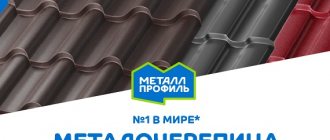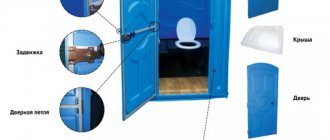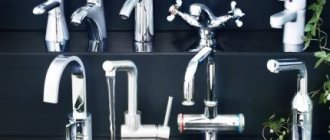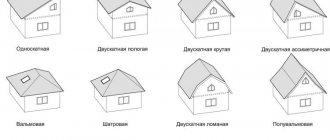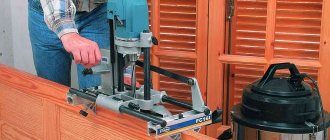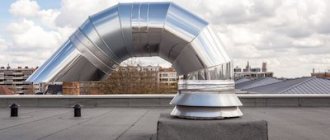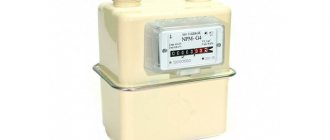The question of how to choose metal tiles for a roof can cause a lot of trouble. At first glance, all samples and images in catalogs look the same, and promise only quality and reliability. But in reality, you have probably already heard about roofs made of this material, which literally after a year begin to lose color, sag or become covered with rusty streams.
And at the same time, the neighbor’s roof, for example, looks like new, for the 10th year already! How is this possible? After all, both there and there are metal tiles... Let's tell you a secret: it's all about the quality of the metal, the coating and the technology for manufacturing such a roof. And we will teach you to understand all this.
Criterion No. 1. Sheet thickness
The thickness of the produced metal tiles varies from 0.4 to 0.7 mm. Let us warn you right away: a metal thickness of 0.4 mm for metal tiles is fraught with the fact that dents can easily remain in it. Even from an apple falling from a tree. And any dent is another stretch and thinning of the protective coating, which leads to a decrease in its service life. This metal is so thin and bends so much that it essentially resembles a tin can. It is difficult to work with, especially when it comes to covering the roof.
It is also worth taking into account small companies that produce metal tiles. This is how they survive among giant competitors, have you ever wondered? It's all about the seasonality of demand: usually it is May-June, and at this time it is quite difficult to buy roofing material from a trusted supplier. Then people turn to little-known companies that make a living from such orders.
But instead of high-quality galvanized steel with a polymer coating, which is also in short supply at this time, they use cheap Chinese raw materials. And they often persistently offer to install metal tiles on the roof themselves - so that the 0.4 mm thick steel does not bend or wrinkle during the installation process, and thus you do not suspect fraud. And with skill and experience, such sheets can really be installed without damage. Just how long will such a roof last?...
A striking example of the use of low-quality metal tiles:
As they say, the miser pays twice. In post-Soviet countries, it is indeed considered normal to repair or change the roofing covering after 10 years, while abroad roofs look like new even after 20 years. And, of course, they cost more, which is explained by the “important investment in the house.”
That’s why you should buy metal tiles that are initially high-quality, and not cheap ones, and especially not fake ones. Because repairs and replacements will be more expensive in a few years, not to mention life-threatening roofing work.
Comparison with analogues
To get a better idea of the differences between different roofing materials, let’s look at other types of roof coverings in a comparative table.
| Material | Service life, years | Fire hazard | Noise level | Health safety | Strength | Price, rub/sq.m |
| Metal tiles | 50 | safe | high | safe | high | 335 |
| Asbestos cement slate | 30 | safe | short | harmful | low | 220 |
| Euroslate | 20 | safe | short | harmful | low | 235 |
| Corrugated sheet | 45 | safe | high | safe | high | 235 |
| Bituminous shingles | 25 | safe | short | safe | low | 240 |
| Ceramic tiles | 150 | safe | short | safe | high | 1 407 |
Criterion No. 2. Steel quality
Large plants usually work with three types of steel - Russian, Asian and European. Today the following countries produce metal tiles from European steel:
- England, Corus company.
- Finland, RUUKKI company.
- Belgium, Arcelor company.
- Sweden, SSAB company.
Russian steel for the manufacture of metal tiles is produced in cities such as Magnitogorsk, Cherepovets and Lipetsk.
And for obvious reasons, Asian steel is considered the lowest quality. At one time, it quickly flooded the Russian market, and even today it is sometimes sold under the guise of being produced in other countries. You can often find metal tiles on sale that have no protective layer at all: the paint was applied to bare steel!
That is why this roofing covering cannot be purchased just anywhere or from anyone, especially on the market without any markings and accompanying documents. Unfortunately, today it is Severostal that is often counterfeited in this way, from which, in fact, only a sticker remains.
A variety of materials are also used for the manufacture of metal tiles:
Installation
To avoid any difficulties during installation, the manufacturer's instructions describe each step of the installation technology, answering which insulation is best to choose, which waterproofing and vapor barrier to use. The work is carried out in the following order:
- First, a waterproofing film is laid directly on top of the rafter legs. It is rolled out in strips with an overlap of 15-20 cm. For better waterproofing, the joints can be glued.
- Sheathing slats are installed perpendicular to the rafters. The first batten is installed 3-5 cm higher so that it is covered by the outer edge of the module.
- Counter battens are fixed on top of the sheathing along the rafter legs.
- First, the starting coating module is fixed, then the next one on the left side of it. Next, the sheet located above the starting one is laid, after which they move on to the fourth element, located above the second.
Differences in laying regular and modular tiles
Do-it-yourself installation of modules
Important! There are popular posts on the Internet where bitumen and modular shingles are cut with a grinder. In fact, it is impossible to use grinding machines to cut these materials, since due to the abrasive effect on them, sparks appear that burn micro holes in the protective layer.
Criterion No. 3. Zinc layer
This is another important parameter for choosing metal tiles. So, the overall service life of the entire roof depends on the thickness of the protective zinc layer under the polymer coating. Why? Because the thicker this zinc layer, the longer the metal tile resists any impact, including corrosion.
And now - a little entertaining chemistry:
You will be interested to know that the first brick in the destruction of metal tiles from old age is laid at the factory! It's all about its form. The fact is that when a simple flat sheet is formed into a roofing bend under pressure, where the steel sheet has a small bending radius, the protective layer is already deformed. Even if it is not noticeable at first glance. It’s just that this layer is stretched to the maximum (due to the fault of the press), becoming significantly thinner, and its protective properties are reduced significantly. In simple terms, these beautiful curves are usually the Achilles heel of modern metal tiles.
In practice, all this looks even simpler: just take two samples of metal tiles, and scratch both deeply with a nail. Place them outdoors and wait two to three weeks of rain. The first streams of rust will be on the metal tiles where the zinc layer is smaller. And if the roofing material was made conscientiously, and the zinc content is at least 225 g/m2, then rust will not appear at all.
That is why the thicker the protective layer of zinc, the better it is for the metal tile itself. This is why there is GOST 14918-80, which controls its quality, which states that the amount of zinc on the surface of the metal should be at least 142.5 grams per 1 square meter. Those. This is the thickness of zinc at 10 microns. If you hear that somewhere there is less practice, we are talking about scammers. The standard indicator for the zinc content in metal tiles is 275 g/m2.
But most brands of domestically produced metal tiles use Russian or Asian rolled steel, where the amount of zinc does not exceed 120-180 g per square meter. Such products, despite the polymer coating, do not last long. The problem is that it will be quite difficult for you to check the thickness of zinc on a metal sheet, even with the help of special tools.
Video description
The following video will help you understand the differences between these two structures and appreciate how much simpler the skeleton of a roof trimmed with metal sheet looks:
Thus, steel products clearly take precedence in the simplicity and speed of installation of the under-roof structure. They are better if we consider this design from the point of view of which roof is cheaper: metal tiles or soft roofing. Because the first one requires less materials.
In addition, if you initially wanted to make a metal roof, and then changed your mind in favor of a soft one, nothing will stop you from laying OSB on the finished sheathing. If it is decided to replace the flexible tiles with steel ones, then the sheathing will have to be dismantled and re-attached taking into account the required pitch.
Difficulty in laying the coating
It cannot be said that the installation of both materials is complicated: the technology is simple in both cases.
- The metal tiles are laid on the sheathing, aligned with the eaves overhang and screwed with galvanized self-tapping screws with a press washer according to the diagram. It is important to screw the fastener into the groove under the protruding profile step, under which the sheathing board should pass.
Scheme of fastening sheets of metal tiles Source krovlyakrishi.ru
Criterion No. 4. Design and shape
So, metal tiles are produced today in different shapes and different geometries, which affect not only the aesthetic qualities of the finished roof, but also its durability:
And depending on the height and depth of the metal tile waves, today its main design types are distinguished:
Noise insulation
A metal tile roof is a “pie” of several layers. The function of a sound insulator in it is performed by thermal insulation.
If you have a used attic or attic, we recommend insulating the slopes. The thermal insulation layer absorbs sounds, making the attic and living space warm and quiet.
If the attic is not used, we recommend insulating its floor (or the ceiling of the living space) so that heat does not escape from the house.
For additional sound insulation, an anti-condensation coating is applied to the inner surface of the metal tile. It not only protects the roof from condensation, but also absorbs sound.
The insulated roof made of flexible tiles is a multi-layer structure. It also provides good sound insulation. You are unlikely to hear rain pattering on the roof or birds walking.
Conclusion: roofing made of flexible and steel tiles effectively protects against noise. In both cases, the function of a sound insulator is performed not so much by the facing material as by the other components of the roofing “pie”.
Criterion No. 5. Protective covering
Price is often the very first criterion for choosing metal tiles for a roof. Because The situation with foreign currency in this period is not very stable, we will not give you typical prices, but only compare. First, at the price, which depends on the type of sheet covering:
- So, there has always been and is more expensive - plastisol.
- Behind it is polyurethane.
- Matte polyester is slightly cheaper.
- And the most affordable is glossy polyester.
Visually:
Now let's compare them:
Option #1 - Pural
Pural as a metal coating has been on the world market for more than 20 years, and during its existence it has never had any serious complaints.
But only one company in the world makes metal tiles coated with Pural - the Finnish Ruukki. And rental is carried out in the following productions:
- Pural Ruukki, there are production facilities in Russia.
- Granite HDX Arcelor, rented by several companies.
- Prisma Corus, only available at Metalprofil.
- Quarzit Arcelor, rented by Grand Line.
Pural is considered the best coating for metal tiles that exists today.
Compare the practicality of different coatings:
Option #2 - polyester
Polyester is considered less durable than polyurethane.
Carefully study the installation instructions for the selected metal tile - you may be unpleasantly surprised by some aspects! For example, all cuts on sheets coated with polyester must be immediately treated with metal paint. And this is additional trouble when working at heights, where there is already little comfort.
Polyester fades almost imperceptibly, which is good. The warranty on it is about 10 years. High-quality metal tiles with a polyurethane coating and a zinc layer content of 275 g/m2 can last more than 50 years!
Option #3 - plastisol
If the climate of your area is cold and there is never any heat in the summer, plastisol is generally an ideal coating for your roof. Because under the scorching rays of the sun, when the roof gets very hot, the plastisol bursts and the roof already looks peeling.
Option #4 - premium coatings
There are also premium coatings for metal tiles such as Solano, Agneta and Prisma. The zinc layer used here is 275 g/m2, with a steel thickness of 0.5 mm.
Prism as a coating has been around for over 6 years. But there is one caveat. The advertising booklet about metal tiles with Prizma coating indicates that cathodic protection against corrosion is implemented here. But it is possible if the technology involves class 1 galvanizing, and products that are sent to Russia no longer fall under this parameter. Naturally, not a single sales consultant will tell you about this - you just need to carefully study the technical products.
Velor is a very beautiful, velvet-like coating. It attracts the average buyer because it shimmers unusually in the sun.
Option #5 - coating with granules
Granulates make the coating of metal tiles rougher and more beautiful, as well as safer:
Option #6 - imitation coating
This coating for metal tiles allows you to achieve very beautiful visual effects:
Quantity of technical waste
To ensure that there is virtually no technical waste left during installation, we recommend ordering metal tiles according to the size of the object. This way you will avoid trimming the material and will not overpay for excess material. Metal Profile specialists produce metal tiles from 0.5 to 8 meters in length in 1 cm increments. This allows you to select a material that is ideal for objects of any size - both for a narrow canopy and for large slopes.
Soft tiles are made in the form of small strips about 1 m long and about 40 cm wide. The material is suitable for roofs of any size. But technical waste will still remain, since the plates of flexible tiles are laid offset relative to each other. The material must be trimmed for installation on gables, ridges, valleys, and in areas adjacent to walls and chimney pipes.
Conclusion: both materials differ in the low amount of waste when installing roofs of simple shapes. The main thing is to correctly calculate the amount of flexible or steel tiles. When installing complex roofs, the amount of waste increases slightly, since the material has to be trimmed.
Criterion No. 6. Color and texture
RAL is a standard color palette for metal tiles. RaColor (RR) is a color map developed by Ruukki in collaboration with Scandinavian architects. The colors were specially selected to harmonize as much as possible with the landscape and other buildings.
In total, this is more than 1000 shades, of which 17 are within the standard color range and another 200 in the product range. Moreover, these are not just colors - these are real brand and design solutions, to which such global giants as Carlsberg, PepsiCo, Coca-Cola and IKEA had a hand.
But here there is a catch. So, if you chose the color of your future roof according to the RAL palette, then you will no longer find exactly such metal tiles with a polyurethane coating - this series is marked not according to RAL, but according to RR.
But please note that the shades of the metal tile colors you choose, if you see them on the screen, may not match the actual color of the future roof. The thing is that each of us has his own monitor brightness and contrast settings: some people like the color to be pure, while for others it hurts their eyes even at 10% of the parameters. Conduct an experiment now: open the virtual palette of metal tile colors and play with the same contrast settings. Does the selected color change noticeably?
It’s better to order a color catalog and be sure to look at a sample. By the way, even a high-quality booklet can convey color with distortion, because... For more precise parameters you need expensive paper and an expensive laser printer. And the company will not accept claims after purchase: the catalog and website were created for initial information only.
Our works
Reconstruction of the roof in Pozdnyakovo
Replacement of roofing in Dzerzhinsky
Roof installation in EKP "Monolith"
Reconstruction of the roof in Gorodishche
Criterion No. 7. Life time
The warranty period for metal tiles today varies from 10 years to 50. It all depends on the quality of the raw materials, the profiling process and the shape of the tiles. Now we will tell you one secret: each material has its own critical degree - that degree after which the material cannot withstand and produces microcracks.
You won’t notice them with the naked eye, but be sure to expect problems in the future. That’s why it’s so important that the manufacturer’s equipment is good, easily and accurately adjustable, otherwise it’s easy to set the “correct” radius too high and end up with a defect.
Agree, those companies that are confident in the quality of their products always give a long shelf life. The champions in this regard are Ruukki and Metal Profile.
Easy to use
Metal roofing is easy to maintain. We recommend washing off accumulated dust and dirt several times a year. To do this, you don’t have to go up to the roof - just water the roof with water from a hose.
There is no need to paint metal tiles or treat them with protective compounds. There are no additional costs during operation.
Flexible tiles do not need to be tinted or treated with chemicals. But it requires more careful care. A soft tile roof should be cleaned regularly. The material has a rough texture, which is why dust constantly settles on it. It is not recommended to water flexible tiles with water from a hose - under the pressure of the jet, the granules may crumble and “bald spots” will appear on the roof. This negatively affects the functionality of the roof and its appearance.
If you clean the roof yourself, it can take a long time. If you turn to specialists every time, get ready for regular costs. If you don't clean your shingles, mold, moss and lichen can grow on the shady side of your roof. To get rid of them, flexible tiles will have to be treated with chemical solutions. You may need special equipment and professional help.
Conclusion: metal tiles are unpretentious, easy to care for - just rinse them with water from a hose sometimes. Flexible tiles often require regular maintenance. If it is not cleaned, moss, mold, and lichens may appear on the roof. They can worsen the appearance of the roof and shorten its service life.
Criterion No. 8. Production
The durability and practicality of metal tiles in factory conditions are determined by the following points:
- Using high-quality material, where the thickness of steel alone is 0.50 mm, and the zinc content is not lower than 225 g.
- The use of a durable coating is better than polyurethane.
- Modern equipment in production.
- Quality control in accordance with international standards.
It is important whether the manufacturer has its own quality control laboratories, how high-tech equipment it uses, and whether everything complies with GOSTs. In addition to giant companies, manufacturers such as Profil Keskus and Samesor can boast of good equipment today.
Metal tiles are mainly produced by cold rolling. A sheet is simply driven into the machine, and a heavy tool literally squeezes the shape out of it. And this method has many disadvantages, but only large manufacturers engage in hot rolling. We have prepared more detailed information for you in the form of a diagram:
For example, metal tiles are manufactured using a strictly defined technology, where air temperature is important (it affects the flexibility of the material, and, therefore, its integrity after rolling).
Here, for example, is how metal tiles are produced at two large factories in the world:
Another interesting point. Metal tiles are always of worse quality from the manufacturer who also produces sandwich panels at the same time. Why? The fact is that in a sandwich it is important that the insulation adheres well to the metal, and therefore the reverse side of the sheets is treated with epoxy, which is inferior in quality to polyester, but interacts better with glue. That’s why in world practice they don’t like it when someone produces both furniture and cheap used wood at the same time.
Comparative analysis of materials
Even having understood the features of each material, it is impossible to definitely say which one is better. It depends on what kind of roof the home owner wants to make and how much he is willing to spend on it.
For example, if this is the roof of an attic floor, the requirements for heat and sound insulation come to the fore, which can be ignored when installing a cold attic. If the roof structure is complex, broken, there may be a problem with excessive consumption of material, etc.
To understand whether flexible tiles or metal tiles are better in your case, you need to compare the characteristics of the materials according to parameters that are important to you. Below is a complete comparison of all points from which you can choose the ones you need.
Difficulty in installing the roof structure
There are few differences between the design of the roofing pie for metal and soft tiles, but they are significant. Let's consider the most popular scheme for its installation with insulation.
Roofing pie diagram Source userapi.com
If we consider all layers from bottom to top, then up to a certain level they are the same for all materials. A vapor barrier is attached under the rafters, and a finishing coating is installed on top of it. This is the inner part. We are interested in the outside.
- The rafters are installed in increments equal to the width of the insulation (50-60 cm).
- Thermal insulation material is laid between the rafters.
- It is covered with a waterproofing membrane that protects the insulation from getting wet when condensation gets into it.
- To create a ventilation gap, a counter beam 40-50 mm thick is nailed to the rafters on top of the membrane.
- The sheathing is mounted on the counterbeam in a horizontal direction.
This is where the similarities between roofing pies end and the differences begin. Firstly, they relate to the pitch of the sheathing: for metal tiles it should be equal to the pitch of the profile. For soft tiles, this step is relatively arbitrary and is selected taking into account the cross-section of the sheathing, the distance between the rafters and the size of the sheet material from which the solid base will be mounted.
Criterion No. 9. Brand and trust
Let's look at the main products that are currently on the market.
Metal tiles from "Metal Profile"
Manufactured from high-quality steel from Severstal and a number of European suppliers. Standard thickness is 0.5 mm.
This metal tile is distinguished by a considerable selection of high-quality coatings. There are three series of polymer coatings: “Premium”, “Premier” and “Standard”. For the average buyer, this means that you can choose a solution that fits your wallet size. Of course, “Premium” will be more expensive than “Standard”, but they also have a higher guarantee - up to 40 years.
Only Metal Profile produces a coating like Agneta - it looks like copper, but does not develop a patina over time. The result is the effect of a copper roof.
All metal tiles are protected on the reverse side with a special protective layer.
Metal tiles from Severostal
New brands of Severostal are “Steel Silk” and “Steel Velvet”. Severostal is produced by combining two workshops - TsPM-2.
Metal tile Qarzit
The main advantages of Qarzit 30 metal tiles are the polyester treatment of the front side, rather than the usual gray epoxy. Let me explain. Polyester is actually more UV resistant than epoxy.
And the coating of this roofing material is zinoaluminum alloy, where the share of aluminum itself is 5%. Application – 265 grams per square meter. This is good protection against corrosion, especially on cuts.
Metal tiles "Metekhe"
Finnish-made metal tiles with a polyurethane coating have a standard thickness of the front layer of 50 microns, where 20 microns is the primer and 30 microns is the polyurethane itself, modified with polyamide to the desired chemical structure.
The Finnish metal tiles "Metekhe" have significant disadvantages: they are supplied in stock measured lengths. And this is very inconvenient. In addition, many consider these tiles to be of lower quality than the same Ruukki, Arcelor or Corus.
Metal tiles "Grendline"
Grendline metal tiles are made from Asian steel with a thickness of 0.48-0.50 mm, which is coated with polymer in French and Belgian factories. Zinc thickness – 225 g.
Metal tiles "Takkota"
"Takkota" - metal tiles. These tiles are produced at a Finnish factory, which has another brainchild - “Pelti”. In principle, both metal tiles are almost no different from each other, and both are often made from Asian steel, less often from Swedish. But this brand of roofing material is supplied to Russia only with a thickness of 0.4 mm, which is too small.
Grand: protection against burnout
Grand metal tiles have a standard thickness of 55 microns, where 20 microns are primer and 35 microns are polyurethane. Although the base layer is slightly larger than competing brands, this does not provide much of an advantage over other brands.
Ruuki: originally from Finland
This company produces metal tiles with pural coating. However, there is one significant detail - the high price. It is primarily due to the fact that the import of such roofing is subject to a state duty of 15%, while ordinary coiled steel is only 5%. In addition, it is more expensive for the manufacturer to produce something in Finland than in many other European countries.
Ruukki does not mark products with a zinc content below 200 g/m2 with its logos. Ruukki uses inorganic pigments for coloring its products, which do not fade for a long time.
SSAB: the Swedish approach
This company produces thin-sheet metal tiles, which are produced by hot-dip galvanized rolled steel. SSAB is known to European car manufacturers, who provide bodies made of this material with a long-term guarantee against through corrosion.
SSAB uses more than 200 g of zinc per square meter for its Pelti Ja Rauta metal tiles, and the total thickness of this layer is about 19 microns. This corresponds to GOST.
And, finally, the quality of metal tiles is often compared to a cook’s finished dish: a good cook will create magic from ordinary products, but a bad cook will ruin even an octopus. The same applies to roofing.
The fact is that even very expensive and high-quality metal tiles can look pitiful and develop rusty streaks after 2 years, and relatively cheap material feels quite good if it has perfect fastening and a roofing pie. Therefore, be sure to study all our articles on the website about working with metal tiles!
Price
The total cost of a roof consists of the price of the roofing covering, substructure and other elements of the “roofing pie”, installation and maintenance costs.
Metal tiles have an affordable price. The material is mounted on a step lathing; laying a solid base and underlayment is not required, as is the case with flexible tiles. Therefore, there is no need to spend money on additional materials. You can install steel shingles yourself without having to contact professional installers. Metal roofing is easy to care for - just periodically clean it from dirt with water from a hose. It's also easy to do yourself.
Soft tiles can be inexpensive. But its installation is usually more expensive. The material is laid on a solid base and a lining carpet - and this will entail additional costs for materials and installation. As a result, the weight of the roof increases. Often it is necessary to strengthen the load-bearing structures and foundation - this also requires costs for materials and labor. Maintenance of flexible tiles can become a separate expense item. The roof must be treated with protective compounds to prevent mold or moss from appearing on it. It also needs to be cleaned regularly. It is not always possible to do this yourself, because special equipment is required. You may have to contact specialists. Having your roof professionally cleaned can be an expensive undertaking.
Conclusion: metal roofing is an economical and practical solution. Available roofing material requires almost no installation costs. There is no need to strengthen the foundation and supporting structures. There are virtually no operating costs. The cost of a roof made of flexible tiles will probably be higher, since installing a “roofing cake”, strengthening load-bearing structures and foundations, and regular professional roof maintenance is not a cheap pleasure.
So which roof should you choose?
I would choose a soft roof, because I believe that this is the material of the future, and it has a number of advantages over other roofing materials. Of course, it’s up to you to choose; my job is to give advice, professional advice.
If you are planning to build a roof for your home soon, I advise you to call me immediately. I will try to suggest which and how best to make a roof. I look forward to your requests, I’m glad to be of assistance.
If you have questions, ask directly in the form below.
+7(495) 241-00-59
Installation and repair of roofing and facade coverings from economy to VIP class
Calculate online
my experience is your saved money and nerves.
I advise everyone who contacts me, even if you later leave to join another brigade. Ask questions, don’t be shy, I answer everyone - it’s free
+7(495) 241-00-59 I am available for calls 7/24 - I will be happy to help you, please contact me!
Reviews
- Pavel Krestsov: “I bought metal tiles without really knowing what it was. It’s just that friends also roofed recently and responded well, and it was inexpensive. I thought that if I re-covered something, I bought it. It turned out to be very convenient, only noisy in the rain and hail.”
- Alexander Permyakov: “I installed metal tiles a year ago, and since then I almost forgot that I even have a roof. Nothing leaks, no repairs are needed. The main thing is to trust the advice of professionals and do everything correctly. For example, the sheathing must be well dried, otherwise the tiles will move and gaps will remain…”
- Alexey Smirnov: “They put it in five years ago and forgot about it. Of course, they scared us about the rust and the fact that it would be noisy, but nothing, it worked out somehow. But it’s beautiful, they painted it the color we wanted, and now the house looks just like a picture.”
